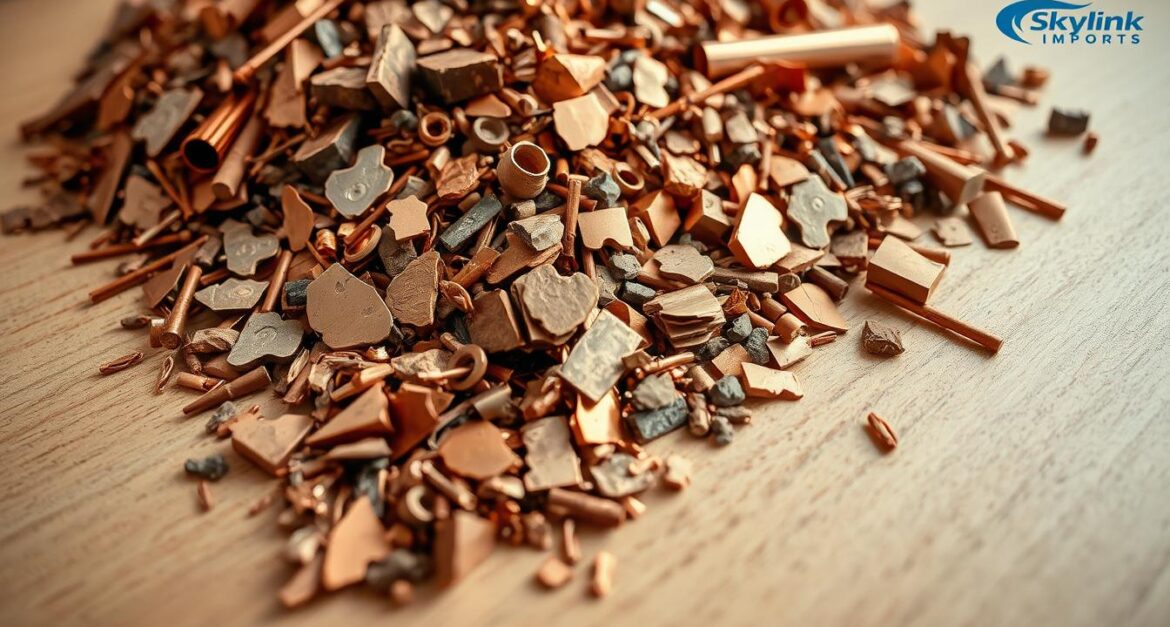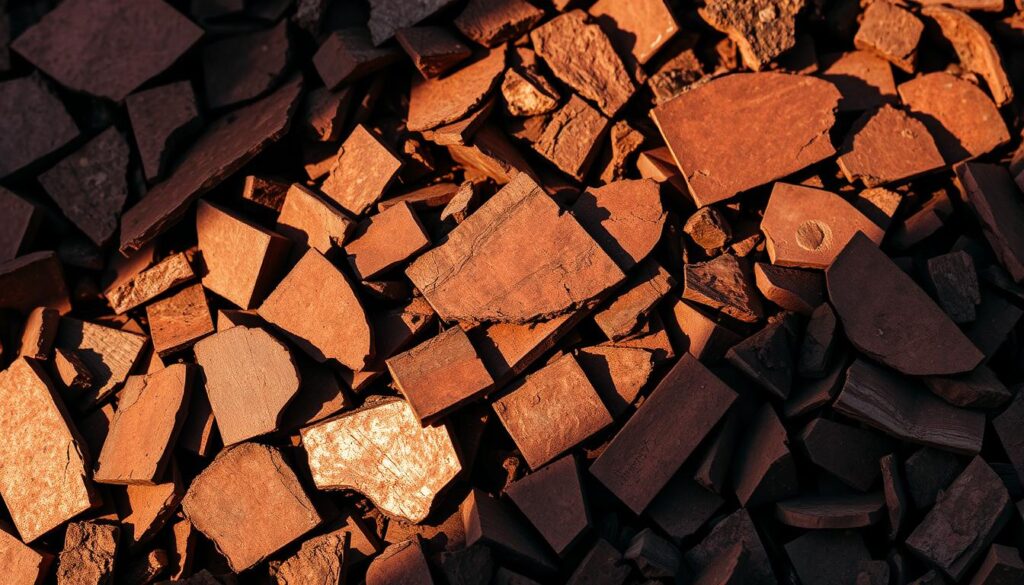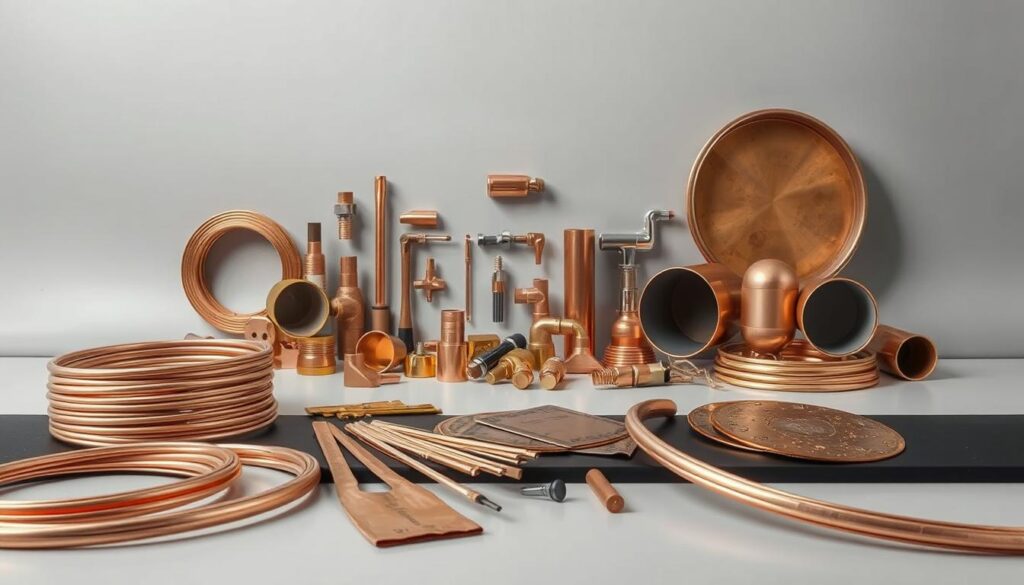
The global demand for copper scrap is on the rise, driven by the growing need for sustainable and eco-friendly practices in industries worldwide. Copper scrap is a highly sought-after material due to its recyclable properties and versatility in various applications.
Skylink Imports, a global import-export solutions provider, specializes in sourcing high-quality copper scrap. With expertise in procurement and logistics, they bridge the gap between manufacturers and markets, ensuring efficiency, reliability, and transparency.
This article will delve into the world of copper scrap, exploring its significance, the benefits of working with Skylink Imports, and what to look for in high-quality copper scrap.
Key Takeaways
- Understanding the importance of copper scrap in the global market.
- The role of Skylink Imports in sourcing high-quality copper scrap.
- Benefits of working with a reliable import-export solutions provider.
- Key factors to consider when evaluating copper scrap.
- The impact of copper scrap on sustainable practices.
Understanding Copper Scrap: An Overview
As the world shifts towards sustainable practices, copper scrap has gained significant attention. Copper scrap refers to discarded or leftover copper materials that can be recycled and reused in various applications.
What Defines Copper Scrap in Today’s Market
Copper scrap is defined by its quality, which is determined by factors such as purity, contamination levels, and the type of copper alloy. The quality of copper scrap directly impacts its value and usability in different industries.
The Global Importance of Copper Recycling
Copper recycling plays a crucial role in conserving natural resources, reducing energy consumption, and minimizing environmental impact. The global copper recycling industry is significant, with various countries contributing to the collection, processing, and trade of copper scrap.
Why Quality Matters in Copper Scrap Trade
Quality is paramount in the copper scrap trade as it affects the final product’s quality and the overall efficiency of the recycling process. High-quality copper scrap ensures that the recycled copper meets the required standards for its intended application.

The following table highlights key factors that influence copper scrap quality and their impact on the recycling process:
| Factor | Description | Impact on Recycling |
|---|---|---|
| Purity Level | Percentage of copper content | Higher purity increases value |
| Contamination | Presence of other materials | Reduces quality and value |
| Type of Alloy | Different copper alloys | Affects usability and price |
Types of Copper Scrap in the Market
Understanding the different types of copper scrap is crucial for buyers and sellers in the market. Copper scrap is categorized based on its quality, purity, and application, making it essential to identify the various types available.
Bare Bright Copper Wire (Premium Grade)
Bare bright copper wire is considered premium grade due to its high purity level. It is clean, uncoated, and untinned, making it highly sought after for its excellent conductivity.
#1 Copper Tubing and Solids
#1 copper tubing and solids are another high-quality category. This type includes clean copper tubing, pipes, and solid copper materials that are free from contamination.
#2 Copper and Mixed Copper
#2 copper includes a mix of copper materials that may be contaminated with other metals or have a lower purity level compared to #1 copper. It is still valuable but requires more processing.
Copper Alloys: Brass, Bronze, and Other Variants
Copper alloys like brass and bronze are widely used in various applications. These alloys contain copper mixed with other metals, offering unique properties suitable for specific industrial uses.

| Type of Copper Scrap | Description | Common Uses |
|---|---|---|
| Bare Bright Copper Wire | High purity, clean, uncoated, and untinned | Electrical wiring, electronics |
| #1 Copper Tubing and Solids | Clean copper tubing and solid materials | Plumbing, HVAC systems |
| #2 Copper and Mixed Copper | Lower purity, may be contaminated | Recycling, industrial applications |
| Copper Alloys (Brass, Bronze) | Copper mixed with other metals | Industrial applications, machinery |
The diversity in copper scrap types allows for a wide range of applications across different industries. Understanding these types is key to maximizing their value.
Everything You Need to Know About Best Quality Copper Scrap: Quality Indicators
The quality of copper scrap is a critical factor that determines its value and usability in various industrial applications. High-quality copper scrap is essential for efficient recycling and for meeting the demands of industries that rely on copper.
Purity Levels and Their Impact on Value
The purity of copper scrap is a primary quality indicator. Higher purity levels directly correlate with higher value, as they require less processing to be reused. Copper scrap is categorized into different grades based on its purity, with Bare Bright Copper being one of the highest grades due to its minimal oxidation and high copper content.
Common Contaminants and Their Detection
Contaminants in copper scrap can significantly reduce its quality and value. Common contaminants include insulation, other metals, and non-metallic materials. Detection methods range from visual inspection to advanced technologies like X-ray fluorescence (XRF) analysis.
International Grading Systems Explained
Different countries and regions have their own grading systems for copper scrap, but there are also international standards. Understanding these grading systems is crucial for both buyers and sellers to ensure they are dealing with the quality they expect.
Quality Testing Methods for Copper Scrap
Various methods are used to test the quality of copper scrap, including chemical analysis, electrical conductivity tests, and physical inspections. These tests help determine the purity and composition of the scrap, ensuring it meets the required standards.
| Quality Indicator | Description | Impact on Value |
|---|---|---|
| Purity Level | Percentage of copper content | Higher purity = Higher value |
| Contamination | Presence of other materials | Lower contamination = Higher value |
| Grading System | Classification based on quality | Higher grade = Higher value |
Understanding and evaluating the quality indicators of copper scrap is essential for maximizing its value and ensuring it meets the needs of various industries. By focusing on purity levels, contaminants, grading systems, and quality testing methods, buyers and sellers can navigate the complex copper scrap market with confidence.
The Economic Value of High-Quality Copper Scrap
High-quality copper scrap has significant economic value, influenced by global market trends. The price of copper scrap is determined by several key factors, including global demand, the availability of raw materials, and the cost of extraction and processing.
Price Determinants in the Global Copper Scrap Market
The global copper scrap market is influenced by various price determinants. Some of the key factors include:
- Global demand for copper
- Availability of raw materials
- Cost of extraction and processing
- Geopolitical factors affecting trade
Market Fluctuations and Forecasting
Copper scrap prices can fluctuate significantly due to market dynamics. Accurate forecasting is crucial for buyers and sellers to make informed decisions.
India’s Growing Role in the International Copper Scrap Trade
India is emerging as a significant player in the global copper scrap trade, driven by its growing industrial needs and recycling infrastructure.
Price Comparison: Virgin Copper vs. Recycled Copper
The price of recycled copper is generally lower than that of virgin copper, making it an attractive option for industries looking to reduce costs.
The economic value of high-quality copper scrap is substantial, and understanding the factors that influence its price is crucial for stakeholders in the industry.
Sourcing Best Quality Copper Scrap
Copper scrap procurement is a complex process that demands careful consideration of quality and reliability. As industries continue to rely heavily on copper for various applications, the demand for high-quality copper scrap has never been more critical.
Reliable Domestic and International Sourcing Channels
Identifying trustworthy sources is paramount. Domestic sourcing often involves working with local recycling centres, scrap yards, and industrial suppliers. Internationally, countries with significant industrial output, such as the United States, Europe, and increasingly, India, offer substantial copper scrap. Utilizing a mix of local and global sources can help in securing the best quality copper scrap.
Verification Methods for Quality Assurance
To ensure the quality of copper scrap, several verification methods are employed. These include visual inspection, chemical analysis, and the use of advanced technologies like X-ray fluorescence (XRF). Such methods help in identifying the purity and composition of the copper scrap, thereby ensuring it meets the required standards.
Common Pitfalls in Copper Scrap Procurement
Procurement of copper scrap is fraught with challenges, including contamination, misgrading, and fraudulent activities. Being aware of these pitfalls and implementing stringent quality control measures can mitigate these risks.
Building Relationships with Trustworthy Suppliers
Establishing long-term relationships with reliable suppliers is key to consistent quality. This involves thorough vetting, regular audits, and maintaining open lines of communication. Trustworthy suppliers are more likely to provide high-quality copper scrap and adapt to the evolving needs of their clients.
| Supplier Criteria | Quality Indicators | Reliability Factors |
|---|---|---|
| Reputation and Experience | Purity Levels | Consistency of Supply |
| Certifications and Compliance | Contamination Levels | Flexibility in Pricing |
| Client References | Grading Accuracy | Customer Service |
By focusing on reliable sourcing channels, rigorous verification methods, avoiding common pitfalls, and fostering strong supplier relationships, businesses can secure the best quality copper scrap. This not only enhances their operational efficiency but also contributes to sustainable practices in the copper industry.
Industrial Applications of Copper Scrap
With its excellent conductivity and durability, copper scrap is highly sought after in various industrial applications. Copper scrap plays a vital role in multiple sectors, contributing to sustainable practices and resource conservation.
Manufacturing Sector Uses and Requirements
The manufacturing sector is one of the largest consumers of copper scrap. It is used in the production of various goods, including:
- Electrical machinery
- Industrial equipment
- Automotive parts
Copper scrap’s high quality and purity are essential for meeting the stringent requirements of this sector.
Construction Industry Applications
In the construction industry, copper scrap is utilized for:
- Plumbing systems
- Electrical wiring
- Roofing materials
The durability and resistance to corrosion of copper make it an ideal material for these applications.
Electronics and Electrical Equipment Production
Copper scrap is crucial in the production of electronics and electrical equipment due to its excellent conductivity. It is used in:
- Printed circuit boards
- Wiring and cabling
- Electrical connectors
Emerging Applications in the Renewable Energy Sector
The renewable energy sector is increasingly relying on copper scrap for the manufacture of:
- Solar panels
- Wind turbines
- Energy storage systems
Copper’s high conductivity and recyclability make it a key material in the transition to renewable energy sources.
Environmental Benefits of Copper Scrap Recycling
By recycling copper scrap, we can mitigate the environmental impacts associated with copper mining and production. Copper scrap recycling is a vital practice that offers numerous ecological advantages.
Reduced Mining Impact and Resource Conservation
Recycling copper reduces the need for primary copper mining, which can have devastating environmental impacts, including deforestation and water pollution. By conserving copper resources, we can protect ecosystems and preserve biodiversity.
Energy Savings Compared to Primary Production
Copper scrap recycling requires significantly less energy than producing copper from primary sources. According to the International Copper Study Group, recycling copper can save up to 85% of the energy required for primary production.
Carbon Footprint Reduction
The energy savings from copper recycling translate into a reduced carbon footprint. A study by the Copper Development Association found that recycling copper can reduce greenhouse gas emissions by up to 65% compared to primary production.
| Environmental Benefit | Primary Production | Copper Scrap Recycling |
|---|---|---|
| Energy Consumption | 100% | 15% |
| Greenhouse Gas Emissions | 100% | 35% |
The environmental benefits of copper scrap recycling are clear. By adopting recycling practices, we can reduce the environmental impacts of copper production and contribute to a more sustainable future.
Processing and Refining Copper Scrap
The journey of copper scrap from collection to refining is complex and multifaceted. It involves various technologies and processes to ensure the production of high-quality copper that meets industrial standards.
Modern Collection and Sorting Technologies
Advanced technologies have transformed the collection and sorting of copper scrap. Automated sorting systems use sensors and AI to differentiate between various types of cop per scrap, enhancing efficiency and accuracy. This modern approach reduces manual labour and increases the purity of the collected copper.
Mechanical and Chemical Refining Methods
Copper scrap refining involves both mechanical and chemical processes. Mechanical methods include shredding and grinding to liberate copper from other materials, while chemical refining involves processes like electrolysis to purify the copper. Electrolysis is particularly effective in producing high-purity copper.
| Refining Method | Description | Purity Level Achieved |
|---|---|---|
| Mechanical Refining | Involves physical processes like shredding and grinding | Up to 90% |
| Chemical Refining (Electrolysis) | Uses chemical processes to achieve higher purity | Up to 99.9% |
Quality Control Throughout the Processing Chain
Quality control is crucial at every stage of copper scrap processing. Regular testing and inspection ensure that the final product meets the required standards. This includes monitoring for contaminants and verifying the purity of the copper.
Innovations in Copper Recycling Technology
The copper recycling industry is witnessing significant innovations, including the use of artificial intelligence and machine learning to improve sorting and refining processes. These advancements are expected to enhance the efficiency and sustainability of copper recycling.
Regulatory Framework for Copper Scrap Trading in India
Understanding the regulatory environment is essential for stakeholders in India’s copper scrap market. The Indian government has established a comprehensive framework to govern the trade, ensuring compliance with international standards and environmental regulations.
Import-Export Regulations and Recent Policy Changes
India’s import-export regulations for copper scrap have undergone significant changes in recent years. The government has implemented policies to promote sustainable recycling practices and reduce the environmental impact of copper scrap trading. Skylink Imports has been at the forefront of adapting to these changes, ensuring compliance and facilitating smooth trade operations.
Quality Standards and Compliance Requirements
Copper scrap traded in India must adhere to strict quality standards. The Bureau of Indian Standards (BIS) sets these standards, which include specifications for purity, contamination levels, and other factors affecting the quality of copper scrap.
Documentation and Legal Procedures
Trading copper scrap in India involves complex documentation and legal procedures. Traders must comply with regulations related to the import and export of copper scrap, including obtaining necessary permits and licenses.
Navigating Customs and Duties for Copper Scrap
Navigating customs and duties is a critical aspect of copper scrap trading in India. Traders must understand the applicable duties and taxes, including those related to the copper scrap prices, to ensure compliance and maintain profitability.
| Regulatory Aspect | Description | Impact on Trade |
|---|---|---|
| Import-Export Regulations | Policies governing the import and export of copper scrap | Affects the supply chain and pricing |
| Quality Standards | Standards set by BIS for purity and contamination | Ensures quality and reliability |
| Customs and Duties | Applicable duties and taxes on the copper scrap trade | Influences profitability and competitiveness |
How Skylink Imports Facilitates Copper Scrap Trade
Skylink Imports has emerged as a pivotal player in the global copper scrap trade, offering comprehensive solutions that cater to the diverse needs of the industry. With its headquarters in Calgary and strong operational roots in India, Skylink Imports specializes in sourcing, procurement, and logistics for a wide range of products, including copper scrap.
Comprehensive Global Sourcing Solutions
Skylink Imports provides the best copper scrap to manufacturers worldwide, leveraging its extensive network of suppliers to source high-quality materials. The company’s global reach enables it to cater to the specific needs of its clients, ensuring timely delivery and competitive pricing.
Rigorous Quality Assurance Processes
Ensuring copper scrap quality is paramount for Skylink Imports. The company employs rigorous quality assurance processes, including thorough inspections and testing, to guarantee that the materials meet international standards.
Efficient Logistics and Supply Chain Management
Skylink Imports’ expertise in logistics and supply chain management ensures that copper scrap is delivered efficiently and cost-effectively. The company’s streamlined processes minimize delays and maximize customer satisfaction.
Expert Consultation Services for Buyers and Sellers
The company offers expert consultation services, providing valuable insights and guidance to both buyers and sellers in the copper scrap market. This service helps clients navigate the complexities of the trade, making informed decisions that drive their businesses forward.
For more information on how Skylink Imports can facilitate your copper scrap trade needs, email us at info@skylinkimports.com or contact us at +1 (403)266-9394, +91-9041-543543.
Conclusion: Maximizing Value from Copper Scrap
Understanding the intricacies of copper scrap is crucial for maximizing its value. As discussed, the quality of copper scrap significantly impacts its economic value, with factors such as purity levels, contaminants, and international grading systems playing a vital role.
Copper scrap recycling not only offers substantial economic benefits but also contributes to environmental sustainability by reducing the need for primary copper production, conserving resources, and lowering carbon emissions. To capitalize on these benefits, it’s essential to source high-quality copper scrap from reliable suppliers and adhere to best practices in processing and refining.
By staying informed about market trends, regulatory requirements, and technological advancements in copper recycling, businesses can optimize their operations and maximize the value derived from copper scrap. As the demand for copper continues to grow, particularly in emerging applications such as renewable energy, the importance of efficient copper scrap recycling will only continue to increase.
Everything you need to know about the best quality copper scrap revolves around understanding its types, quality indicators, and market dynamics. By leveraging this knowledge, stakeholders in the copper scrap industry can make informed decisions, drive sustainable practices, and capitalize on the economic opportunities presented by copper scrap recycling.
Email us: info@skylinkimports.com
Contact us: Canada: +1 (403) 266-9394
India: +91-9041-543543
USA: +1 (917) 672-6581





